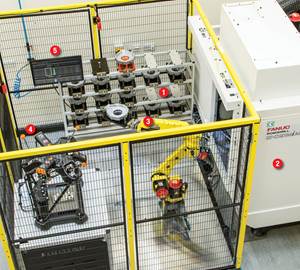Digitizing Tool Data Is Key to Integration with CNC Programming and Other Applications
ISO 13399 is an international standard for the digital representation of cutting tool data. Generic Tool Catalog (GTC) is a complement to ISO 13399 for vendor-neutral classification of cutting tools and data file structures.
Share






ISO 13399 is an international standard for the digital representation of cutting tool data. Generic Tool Catalog (GTC) is a complement to ISO 13399 for vendor-neutral classification of cutting tools and data file structures. These developments link cutting tool information with applications supporting data-driven manufacturing. However, complying with these standards is no trivial task for cutting tool manufacturers. Changing internal product codes and database structures can have a significant impact on personnel and IT resources. Smaller tool companies may face the greatest challenge.
However, the experience of one specialty cutting tool supplier, Destiny Tool (Santa Clara, California) shows that the conversion can be manageable, and it benefits both the company and its customer base. Destiny Tool’s specialty is a series of high-performance end mills for use on non-ferrous and high-temperature alloys.
To make the leap to a fully digitized tool catalog, Destiny Tool solicited the help of MachiningCloud, a developer of cloud-based applications, resources and services focused primarily on cutting tools and related manufacturing data. MachiningCloud provided this manufacturer with the service of mapping its product data into ISO 13399 and GTC formats and publishing them in the cloud. This means that the data can be accessed via the internet from a local computer without downloading entire catalogs, which are very large files. Destiny Tool’s customers can find this product data as a MachiningCloud online resource, eliminating the need to search through printed catalogs, make telephone calls or check multiple websites to find appropriate tooling. By using ISO 13399 and GTC, the product data residing on MachiningCloud is also easily imported into shop software that supports these standards.
Digital tool catalogs represent a major shift in the manufacturing industry. At a glance, the benefits to end users are compelling. Digital tool catalogs help them:
-
Find cutting tools faster.
-
Make smarter CNC cutting tool selections.
-
Quickly create cutting tool assemblies.
-
Simplify the CNC cutting tool workflow.
Time savings reported by users range from 25 to 75 percent when compared to traditional methods of tool selection. Beyond cutting tool selection, CAD/CAM programmers also can increase efficiency by using more productive metal removal rates and improved utilization of manufacturing assets.
Some cutting tool suppliers have concerns, however. Perceived risks to GTC integration include:
-
Brand degradation. A brand’s tools will be compared to other brands where the results appear homogenous.
-
Fewer customers. Customers will see other cutting tool options and may buy those instead, but brands not present in third-party tool marketplaces also risk losing customers when their products can’t be chosen in their preferred software.
-
Less control. Uploading a brand’s digital catalog to a third party results in a loss of control over end users’ experiences.
-
Requires resources. Services to help digitize a brand’s catalog are available, but it still requires significant internal resources.
These concerns must be balanced against many perceived benefits. These include:
-
Better customer data. Users can transmit results to suppliers, thus resulting in better recommendations and product refinements.
-
Increased efficiency. Once a digital catalog is created, maintaining up-to-date information is much easier.
-
More customers. Third-party integration increases reach and exposure, and presents a cutting tool brand among its competition.
-
Ease of use. GTC allows cutting tool brands to digitize without creating a proprietary system.
Perhaps the most important deciding consideration is this: There is an advantage to converting to a digital tool catalog sooner rather than later. Over time, as CAD/CAM programmers use brand-neutral tooling selection software, brands that aren’t present in the GTC format will experience a loss of market share as competitors gain new users. Finally, there is no stopping the movement toward data-driven manufacturing. The availability of cutting tool data in an importable, digital format is giving this movement added momentum.
Related Content
Process Control — Leveraging Machine Shop Connectivity in Real Time
Renishaw Central, the company’s new end-to-end process control software, offers a new methodology for producing families of parts through actionable data.
Read MoreBlueprints to Chips: CAD/CAM Tips and Tricks
This collection of articles delves into the latest CAD/CAM innovations, from AI-driven automation and optimized tool paths to the impact of digital twins and system requirements.
Read MoreJIMTOF 2024 Report: EVs, AI and Autonomous Robots Abound
The 2024 Japan International Machine Tool Fair (JIMTOF) showed how the manufacturing industry is adapting to the needs of electric vehicle manufacturing and adopting new technology including AI and autonomous robots.
Read More5 Stages of a Closed-Loop CNC Machining Cell
Controlling variability in a closed-loop manufacturing process requires inspection data collected before, during and immediately after machining — and a means to act on that data in real time. Here’s one system that accomplishes this.
Read MoreRead Next
Machine Shop MBA
Making Chips and Modern Machine Shop are teaming up for a new podcast series called Machine Shop MBA—designed to help manufacturers measure their success against the industry’s best. Through the lens of the Top Shops benchmarking program, the series explores the KPIs that set high-performing shops apart, from machine utilization and first-pass yield to employee engagement and revenue per employee.
Read MoreAMRs Are Moving Into Manufacturing: 4 Considerations for Implementation
AMRs can provide a flexible, easy-to-use automation platform so long as manufacturers choose a suitable task and prepare their facilities.
Read More
















